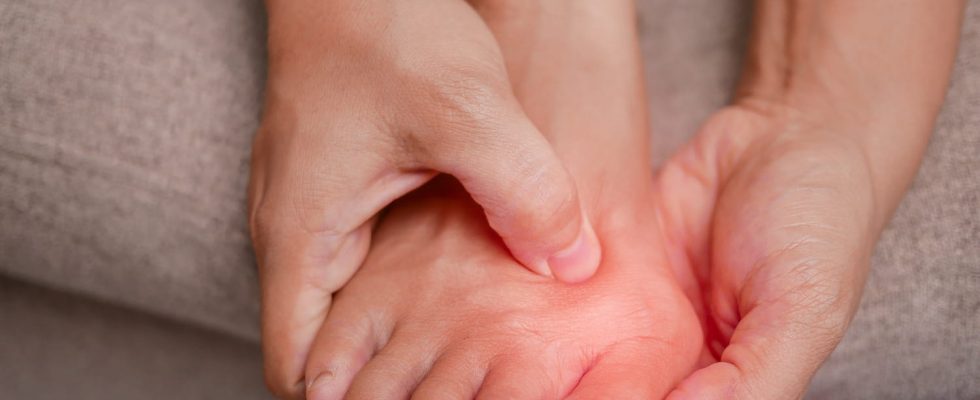A painful, swollen, red toe… can suggest an infection or a joint problem. But not only: here are the possible causes and solutions to relieve pain in the toes.
Toe pain is very common and usually not serious. The pain is more or less intense and can interfere with walking. What are causes of a sore toe ? How to relieve pain?
What causes toe pain?
Toe pain results from many causes. It can follow:
► Trauma (contusion, dislocation or fracture)
► The presence of a callus, due to wearing unsuitable shoes. “Corns and calluses which are caused by a lack of support and/or friction with the shoe. They are generally located at the level of the pulp of the big toe, on the outer edge of the big toe or even at the level of the interdigital space (friction between the big toe and the second toe). One can also find one or more corns in the furrows of the nail or even under the nail”, explain Karine Poirier, podiatrist-podiatrist:
► Sometimes the pain is of infectious origin : repeated rubbing or an ingrown toenail can, for example, lead to wounds that become infected quickly. People with diabetes in particular are prone to these infections, due to the loss of sensitivity in the contact nerves: small wounds are not perceived early enough and end up becoming infected.
► A gout attack can cause a sore, red, and swollen big toe. It is moreover the typical sign of a gout attackthe most common inflammatory arthritis in adult and elderly men.
► The presence of osteoarthritis on the joint, a pathology called hallux rigidus, can also explain pain; it gradually leads to stiffness of the toe. Finally, the hallux valgus, commonly called “bunion” is also particularly painful: it is a bone deformation which gradually deflects the big toe from its axis. “We can suspect a hallux valgus very early, even in children, especially in the case of a hereditary hallux valgus, warns our specialist. The deformation is seen quickly, the big toe tending to deviate outwards.
What are the associated symptoms?
Depending on the origin of the pain, the toe may appear red and swollen, deformed and/or have a skin sore. A thickening of the skin, in the form of a corn or a callus, can also be observed. “In the case of a hallux valgus caused by wearing unsuitable shoes (pointed and high heels), the inflammatory joint crisis between the first metatarsal and the first phalanx will be the first sign of the appearance of hallux valgus”says Karine Poirier.
► For corns and callusesa visit to a professional is strongly recommended: “Only a pedicure-podiatrist treats these conditionsemphasizes Karine Poirier. It painlessly removes corns and calluses, limits their reappearance by offering protection, gives advice on footwear to avoid any new friction and offers suitable equipment to modify the supports if necessary.
► An ingrown toenail must be treated as soon as possible to avoid a severe infection and the formation of a bud: “In order to avoid ingrown nails, you must cut your nails straight, regularly, with pliers or nail clippers.advises our expert. Do not try to go into the corners, but file the angles. In addition, care must be taken to treat any excessive sweating, which would tend to soften the skin and thus promote the penetration of the nail into the furrows. Finally, wearing shoes that are too pointed or too tight is to be avoided. “
► In case of osteoarthritisTHE wearing orthopedic insoles and physiotherapy sessions may help relieve symptoms.
► If the hallux valgus becomes too painful on a daily basis, Plantar orthoses made-to-measure by the pedicure-podiatrist and wider, less high and seamless shoes help relieve pain. If the hallux valgus is too large and painful, its correction by surgery can also be considered.
When to consult?
Corns and calluses can interfere with walking: it is advisable to have them removed by a podiatrist. In the absence of a chronic disease (such as diabetes, heart disease, immunosuppression, etc.), pain related to an ingrown toenail is not a medical emergency if it is quickly taken care of by the pedicure- podiatrist. Nevertheless, care must be taken to treat the wound well to prevent the infection from progressing: if no improvement is observed within 48 hours, it is advisable to consult a doctor.
Thanks to Karine Poirier, Pedicure-Podologist.
